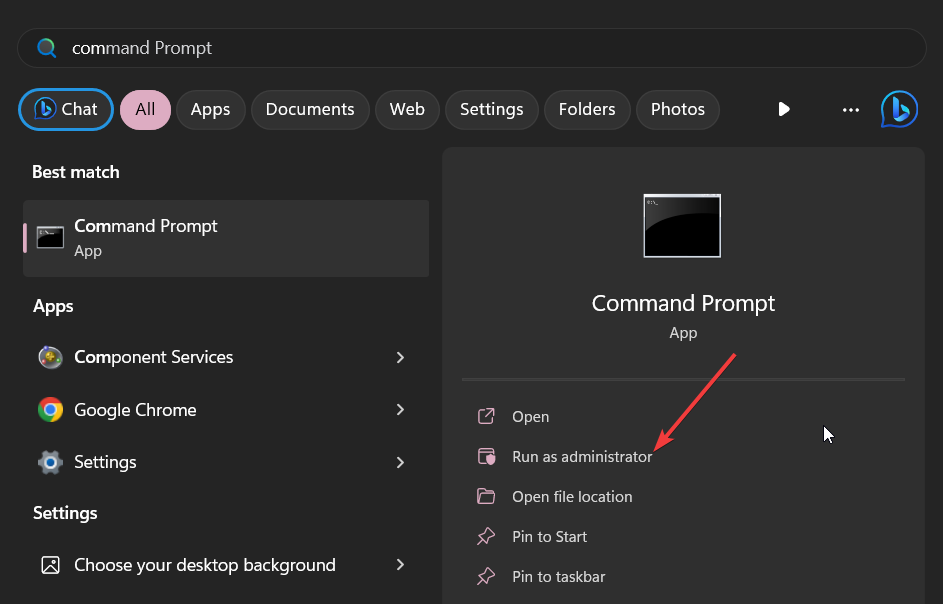Все способы:
- Способ 1: Диалоговое окно «Выполнить»
- Способ 2: «Командная строка»
- Способ 3: Создание ярлыка отмены выключения
- Вопросы и ответы: 1
Способ 1: Диалоговое окно «Выполнить»
Если вы передумали завершать работу Windows 10, и если есть время, то отменить выключение можно, используя диалоговое окно «Выполнить». Для этого нажмите на клавиши «Win + R», затем в строке «Открыть» введите команду shutdown /a и нажмите на кнопку «ОК».

После этого начавшийся процесс выключения будет остановлен, но, скорее всего, некоторые службы прекратят свою работу. Принудительная приостановка отключения позволит сохранить данные, если вы не успели или забыли это делать.
Способ 2: «Командная строка»
Еще один не слишком быстрый, но действенный способ принудительно остановить выключение – это выполнение команды в консоли «Командная строка». По сути, он является альтернативой первому методу и удобен лишь если на момент завершения работы эта консоль уже была открыта:
- Запустите ее от имени администратора, используя строку системного поиска.
- В появившемся окне вставьте
shutdown /aи нажмите на клавишу «Enter».
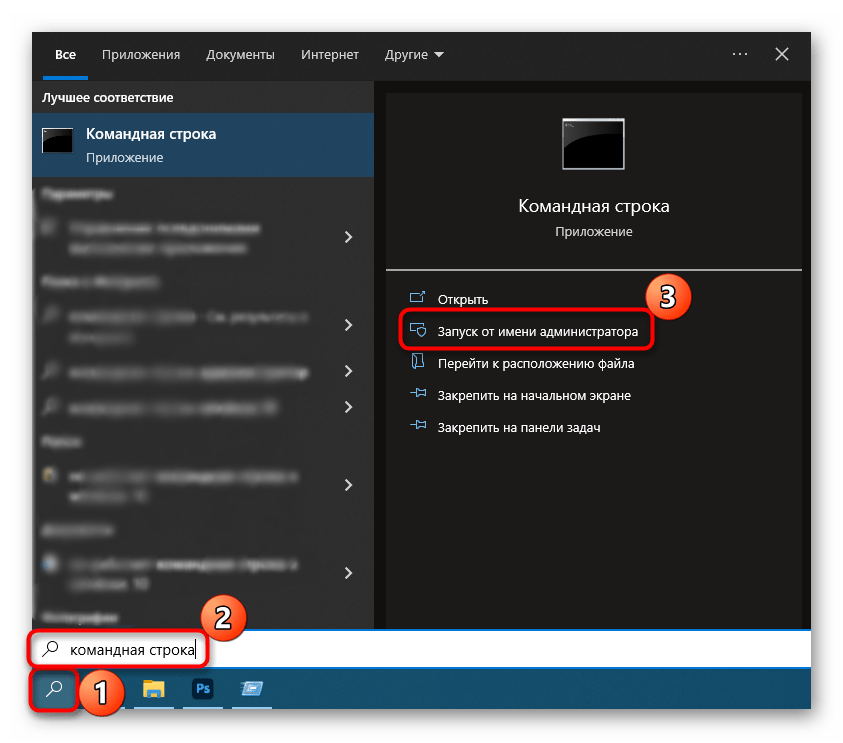
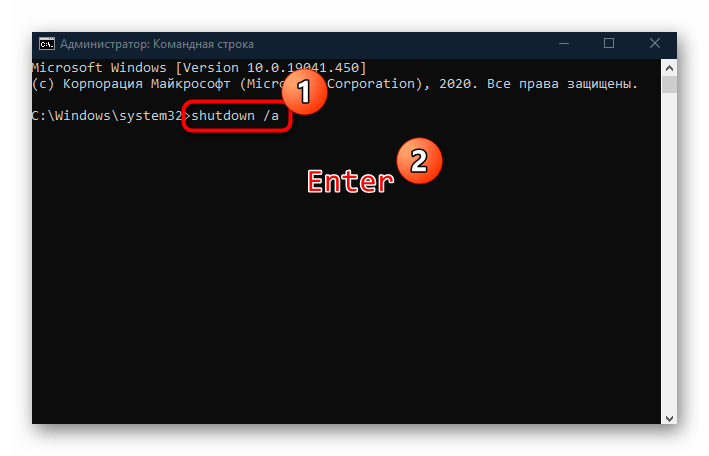
Как и в предыдущем способе, после выполнения команды произойдет принудительная отмена завершения работы Windows 10.
Способ 3: Создание ярлыка отмены выключения
В качестве альтернативного метода можно использовать заранее созданный ярлык. Если позаботиться об этом заблаговременно, то остановить процесс выключения компьютера есть возможность буквально в два клика: достаточно просто запустить ярлык.
- Щелкните правой кнопкой мыши по свободному пространству в любом месте, логичнее всего на рабочем столе. В контекстном меню наведите курсор на пункт «Создать», затем выберите «Ярлык».
- В появившемся окне нужно указать расположение объекта, для этого введите в строке
shutdown.exe –aи кликните по кнопке «Далее». - Затем задайте имя своему ярлыку, например «Отмена выключения», и нажмите на «Готово».
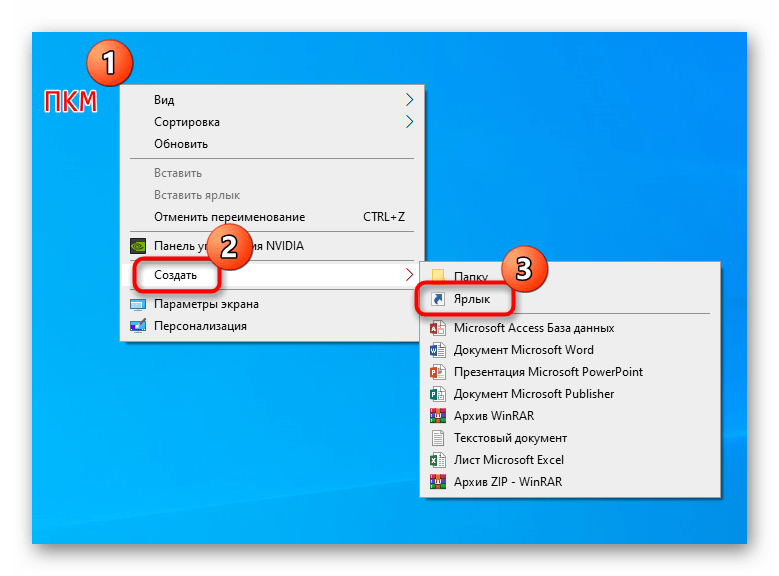
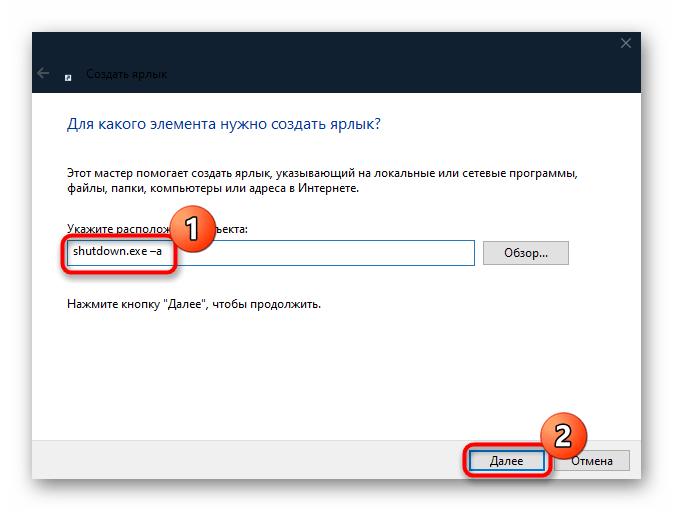
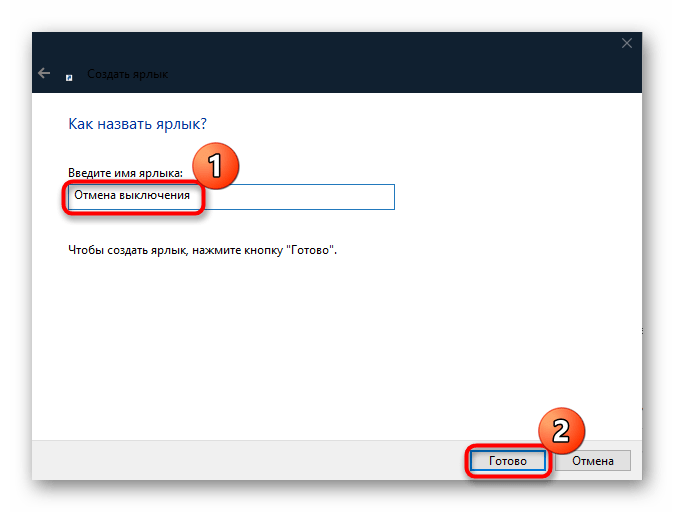
После этого ярлык отмены завершения работы появится в выбранном месте. Для удобства вы можете его немного отредактировать.
Гораздо быстрее вызывать запуск ярлыка сочетанием клавиш, нежели кликом мышкой. Для этого кликните по ярлыку правой кнопкой мыши и перейдите в «Свойства».

Находясь на вкладке «Ярлык», поставьте курсор в строку «Быстрый вызов», затем нажмите на ту клавишу, которая будет использоваться в сочетании с «Ctrl + Alt», и сохраните настройку.
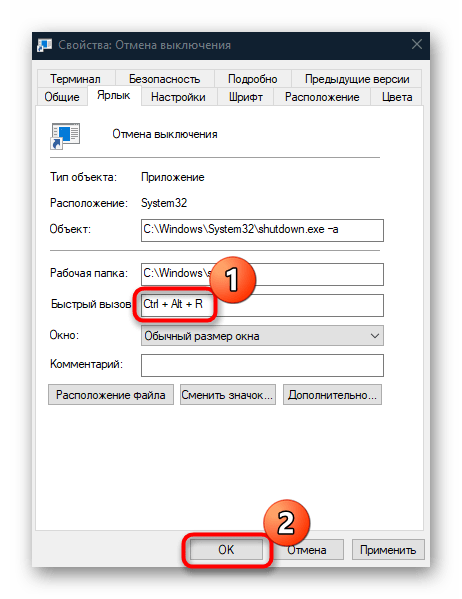
Чтобы у ярлыка была тематическая иконка, на той же вкладке «Ярлык» нажмите на кнопку «Сменить значок».

В новом окне останется подобрать подходящую иконку и подтвердить действие.
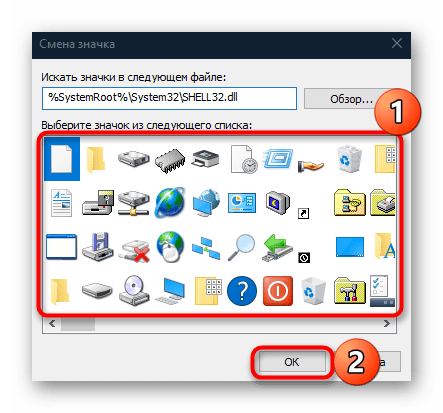
Если вы хотите деактивировать ранее настроенный таймер отключения в Windows 10, ознакомьтесь с другой нашей статьей.
Подробнее: Отключение таймера выключения Windows 10
Наша группа в TelegramПолезные советы и помощь
Download Article
Download Article
- Using Run, Command Prompt, or PowerShell
- Using Power Options
- Video
|
|
Windows 10 has a feature that can automatically shutdown your computer according to a schedule you set. But you might be working or gaming late and don’t want your computer to automatically shut down. This wikiHow will teach you how to cancel auto-shutdown using the run command, the command prompt, or PowerShell. However, if you use power-saving settings to save your battery life when your laptop isn’t plugged into a power source, you may also need to change those settings in Power Options.
-
Pressing the Win + R key combination will open the Run window.
- You’ll find Command Prompt or PowerShell in your Start menu. Since PowerShell is replacing Command Prompt for many modern Windows 10 computers, you can also select PowerShell in the menu that pops up when you press Win + X.[1]
- You’ll find Command Prompt or PowerShell in your Start menu. Since PowerShell is replacing Command Prompt for many modern Windows 10 computers, you can also select PowerShell in the menu that pops up when you press Win + X.[1]
-
shutdown -a. This command will cancel the scheduled shutdown for one time. You’ll have to repeat this process if you want to cancel other scheduled shutdowns.
Advertisement
-
It’s below the place where you entered the code in the Run window and will prompt it to close.[2]
Advertisement
-
You can press Win + I to open Settings, or you can find it in your Start menu next to a gear icon.
-
It should be the first icon in the menu.[3]
-
You should see this in the menu on the left side of the window.[4]
-
This is towards the right side of the window.[5]
-
You’ll see this to the right of your current plan.
-
It’s under the general settings.
-
Double-clicking these will expand their menus.
-
If you want to change the setting for both of these options, repeat the process for the one you didn’t already change.[6]
-
You will not see this if you’re on a laptop.
- Changing the «Sleep» settings to «Never» will ensure that your computer never goes to sleep.
-
A menu will expand below the header.
-
If you want to change the setting for both of these options, repeat the process for the one you didn’t already change.
-
You will not see this if you’re on a laptop.[7]
- These settings will ensure your computer never hibernates, which might drain your battery if your laptop is not plugged into a power source.[8]
- These settings will ensure your computer never hibernates, which might drain your battery if your laptop is not plugged into a power source.[8]
Advertisement
Ask a Question
200 characters left
Include your email address to get a message when this question is answered.
Submit
Advertisement
Video
Thanks for submitting a tip for review!
About This Article
Article SummaryX
1. Press Win + R (to open Run) or open Command Prompt or PowerShell.
2. Enter the following command: «shutdown -a».
3. Click OK (in the Run window) or press Enter (in Command Prompt or PowerShell).
Did this summary help you?
Thanks to all authors for creating a page that has been read 204,998 times.
Is this article up to date?
Introduction
Automatic shutdown in Windows 10 is one of the features of Windows 10 and if you want to use this automatic shutdown schedule on your laptop/PC then read this article on the topic of, How to Schedule Automatic Shutdown in Windows 10.
If you set down the Auto Shutdown Schedule in Windows 10 and suddenly you remember that you have urgent work and want to cancel this auto Shutdown Schedule, then you have to know the procedure to Cancel the Auto Shutdown Schedule in Windows 10.
This tutorial will show you various ways, how to Cancel the Auto Shutdown Schedule or Task in Windows 10.
Method 1. Via run
Step 1. From the Start menu, open the Run dialog box or you can Press the «Window + R» key to open the RUN window.
Step 2. Type «shutdown -a» and click on the «OK» button.
After clicking on the OK button or pressing the enter key, the auto-shutdown schedule or task will be canceled automatically.
Method 2. Via command prompt
Step 1. Open Command Prompt.
Step 2. Type «shutdown -a» and press enter key.
By pressing the enter key, the Auto Shutdown Schedule will be Canceled Automatically.
Method 3. Via windows powershell
Step 1. Open Windows PowerShell. (Alternatively, you can press the «Windows + X» key and click on «Windows PowerShell» to open it.)
Step 2. Type «shutdown -a» and press enter key.
After pressing the enter key, the Auto Shutdown schedule will be canceled automatically.
Method 4. Through the creation of a shortcut icon
Step 1. Right-click on the empty area of the desktop and select «New > Shortcut».
Step 2. Click on the browse button and choose «shutdown.exe» from C/Windows/System32 and add «-a» or you can type directly «shutdown.exe -a» and click on the Next Button.
Step 3. Choose any name for this shortcut that you want, and then click on Finish Button.
Step 4. After clicking on this Finish Button, the Shortcut Icon will be generated.
By clicking the «Cancel Auto Shutdown» Shortcut Icon, you can cancel the Auto Shutdown Schedule or Task and If you want, you can change the default icon of this shortcut, by choosing the properties option.
Conclusion
By following any of the above methods, you can Cancel the Automatic Shutdown in Windows 10.
I hope you enjoyed this article. Follow C# Corner to learn more new and amazing things about Windows 10.
Thanks for reading this article.
Download Windows Speedup Tool to fix errors and make PC run faster
Sometimes, you may get to see a message – The system is shutting down. Please save all your work. Or you may get to see a message – Restart your computer in 10 minutes to finish installing important Windows Updates. Or maybe you clicked on the Shutdown or Restart button accidentally before saving your work, and you’d like to stop or abort the system shutdown and stop this operation. You can create this handy Windows desktop shortcut to help you in such situations.
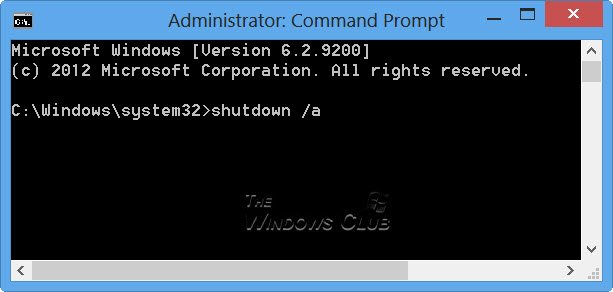
You cannot cancel a restart or shutdown using the Shutdown Event Tracker Windows interface. It is only possible to perform this task from the command line. To cancel or abort the system shutdown or restart, open Command Prompt, type shutdown /a within the time-out period, and hit Enter. It would instead be easier to create a desktop or keyboard shortcut for it. The /a argument will abort a system shutdown and can only be used during the time-out period.
Create Abort System Shutdown shortcut
- Right-click on an empty area on your desktop.
- Select New>Shortcut.
- In the first box of the Create Shortcut Wizard, type: shutdown.exe -a.
- Now click Next and name the shortcut: Abort Shutdown.
- Click Finish.
- Finally, select an appropriate icon for it!
To give this Abort System Shutdown shortcut, a keyboard shortcut, right-click on it > Properties > Shortcut tab. In the Shortcut key box, you will see “None’ written. Click in this box, and press A key from your keyboard. The letters Ctrl + Alt + Del will automatically appear, and will now be your keyboard shortcut to abort shutdown or abort restart. Click Apply > OK.
This can be used only during the timeout period. Remember that you may have only a few seconds to stop the shutdown or restart process from taking effect, so you better have really fast fingers to be able to use this shortcut.
Alternatively, what you can do, is to create a separate shortcut for Shutdown first, as follows:
Right-click on an empty area on your desktop. Select New>Shortcut. In the first box of the Create Shortcut Wizard, type: Shutdown -s -t 30. Click Next. Name the shortcut: Shutdown, and click Finish. Then select an appropriate icon for it!
When you use this shortcut to shut down, you will first get a dialog box stating: Windows will shut down in less than a minute. In our case, it will shut down in 30 seconds.
This will give you 30 seconds to abort the system shutdown. Once the shutdown or restart is aborted, an icon will appear in your system tray.
Click on the icon to make it disappear!
Similarly, you can create a Restart shortcut with a 15 seconds delay using instead: Shutdown -r -t 30
Speaking of shutdown switches, you may want to see Shutdown options in Windows, and New CMD switches for shutdown.exe.
Anand Khanse is the Admin of TheWindowsClub.com, a 10-year Microsoft MVP (2006-16) & a Windows Insider MVP (2016-2022). Please read the entire post & the comments first, create a System Restore Point before making any changes to your system & be careful about any 3rd-party offers while installing freeware.
Readers help support Windows Report. We may get a commission if you buy through our links.
Read our disclosure page to find out how can you help Windows Report sustain the editorial team. Read more
You might have accidentally turned on the automatic shutdown timer on your Windows PC and now looking for ways to turn it off. Because, if you don’t turn it off, your PC will turn off after the said time.
In this guide, we will give you a guide on how to turn off the shutdown timer. The methods explained here will be applicable to both Windows 10 and 11 computers. Let us check it out.
Why should I turn off the shutdown timer on Windows 11 & 10?
There are several reasons why you would want to turn off the automatic shutdown timer on your PC. Some of the reasons are mentioned below.
- There is a pending Windows update going on. If your PC shuts down during that time, then you need to download the update again from the start.
- You are working on something important and if the automatic shutdown happens, then you might lose track of what you were doing, and also lose important files if they aren’t saved.
- There might be an important installation that is going on and if there is an automatic shutdown in place, you will abruptly close the installation and cause multiple issues.
Let us take a look at the steps that will help how to turn off the shutdown timer on both the Windows 11 and Windows 10 PC.
How to turn off the shutdown timer?
1. Using the Run dialogue
1.1 Windows 11
- Press the Win + R keys to open the Run dialogue.
- Type shutdown-a and press OK.
- If you see a message Logoff is canceled. The scheduled shutdown has been canceled, which means that the shutdown timer has been turned off.
1.2 Windows 10
- Press the Win + R keys to open the Run dialogue.
- Type shutdown-a and press OK.
- If you see a message Logoff is canceled. The scheduled shutdown has been canceled, which means that the shutdown timer has been turned off.
Using the Run dialogue to turn off the shutdown timer on your PC is a simple way to accomplish the task. All you need to do is run a simple command and get the job done.
- Windows 11 Shutdown After Inactivity: 4 Ways to Stop it
- Windows Shuts Down Instead of Restarting: 4 Ways to Fix it
2. Use Command Prompt
2.1 Windows 11
- Press the Win key to open the Start menu.
- Type Command Prompt and run it as an administrator.
- Type the below command and press Enter.
shutdown -a - You will see a message Logoff is canceled. The scheduled shutdown has been canceled, confirming that the shutdown timer has been turned off.
2.2 Windows 10
- Press the Win key to open the Start menu.
- Type Command Prompt and run it as an administrator.
- Type the below command and press Enter.
shutdown -a - You will see a message Logoff is canceled. The scheduled shutdown has been canceled, confirming that the shutdown timer has been turned off.
Running a command on your Windows 10 and Windows 11 can also help you turn off the shutdown timer on your PC.
3. Create a desktop shortcut
3.1 Windows 11
- Right-click on your desktop and select Shortcut.
- In the Create a shortcut wizard enter type the below location in the text area, and click Next to continue.
C:\Windows\System32\Shutdown.exe -a - Give the shortcut any name you like and hit the Finish button to complete the wizard.
- Once the shortcut is created, simply open the shortcut anytime you would like to turn off the shutdown timer.
3.2 Windows 10
- Right-click on your desktop and select Shortcut.
- In the Create a shortcut wizard enter type the below location in the text area, and click Next to continue.
C:\Windows\System32\Shutdown.exe -a - Give the shortcut any name you like and hit the Finish button to complete the wizard.
- After the shortcut is created, all you need to do is open the shortcut anytime you would like to turn off the shutdown timer.
When you run this desktop shortcut, you will see a window appear just for a split second and then disappear, confirming that the action has been successfully taken.
This desktop shortcut will help you to turn off the shutdown timer if case the automatic shutdown is scheduled so frequently in your Windows 11 PC.
That is it from us in this guide. You can read our guide on how to fix Windows 11 shutdown box keeps popping up randomly in between your tasks.
Moreover, several readers have reported that their Windows 11 PCs randomly or automatically shut down. You can resolve this issue by applying the solutions mentioned in our guide.
Let us know in the comments below, which one of the above solutions resolved your query on how to turn off the shutdown timer on Windows 11 and Windows 10.
Sagar Naresh
Sagar is a web developer and technology journalist. Currently associated with WindowsReport and SamMobile. When not writing, he is either at the gym sweating it out or playing country music on his guitar.
He is an avid traveler and has been to 15 countries, going to more places soon. TRAVEL and WORK is his mantra for a peaceful life.




















